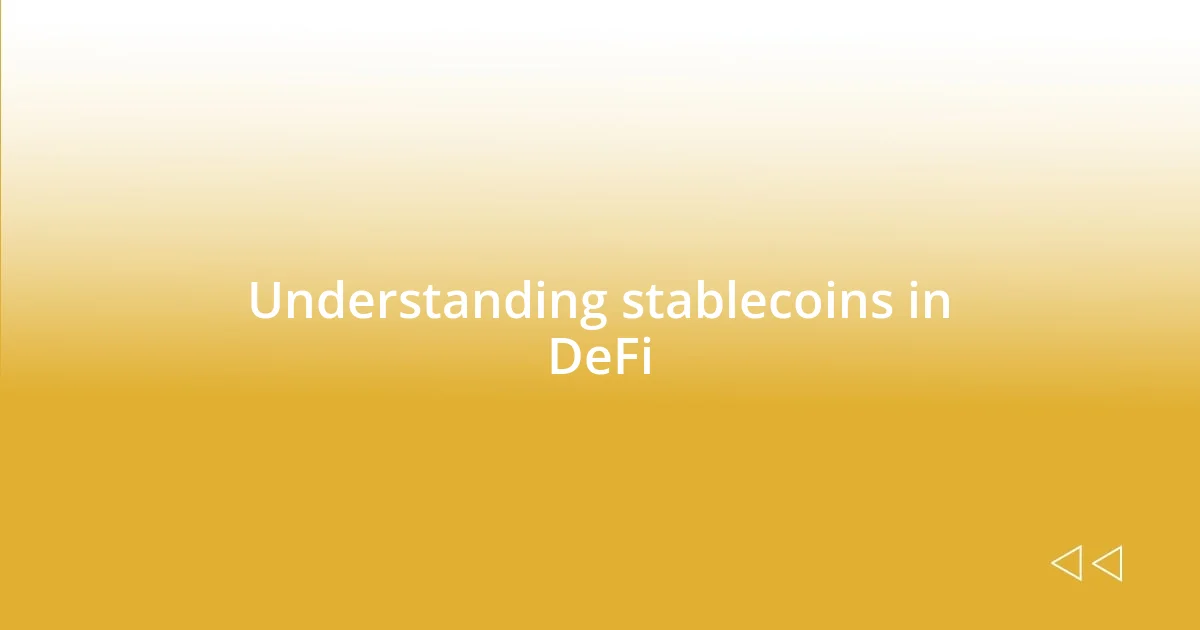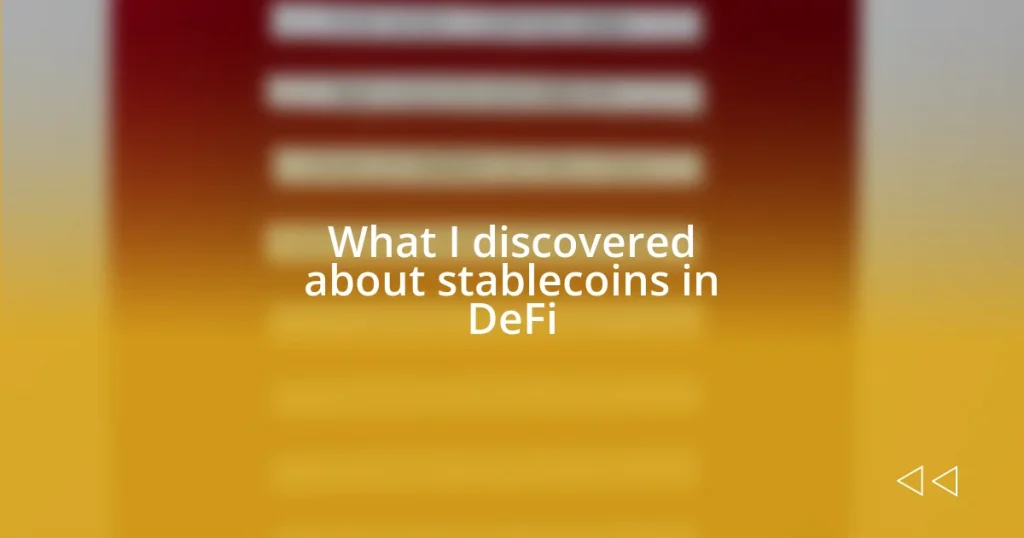Key takeaways:
- Stablecoins bridge the gap between volatile cryptocurrencies and fiat currencies, providing stability and opportunities for seamless cross-border transactions in DeFi.
- There are three main types of stablecoins: fiat-collateralized (backed by fiat currency), crypto-collateralized (secured by other cryptocurrencies), and algorithmic (maintaining value through algorithms without collateral).
- Choosing the right stablecoin requires considering factors like backing transparency, liquidity, regulatory compliance, intended use case, and community trust, while also being aware of the inherent risks associated with each type.

Understanding stablecoins in DeFi
Stablecoins play a pivotal role in the DeFi (Decentralized Finance) ecosystem, bridging the gap between volatile cryptocurrencies and traditional fiat currencies. When I first encountered stablecoins, I was struck by how they offered a sense of stability in a world filled with sharp price fluctuations. Can you imagine trading in an environment where your assets might drop 20% overnight? Stablecoins provide that antidote, allowing users to conduct transactions and earn interest without the constant anxiety of value depreciation.
What genuinely fascinates me about stablecoins is their underlying mechanics—most are pegged to assets like the US dollar, creating a safety net in volatile markets. I remember using a stablecoin for the first time to earn yield in a lending protocol. It was a relief to know that my assets would remain relatively stable while still participating in the DeFi space. Have you ever felt the rush of earning without the fear of losing capital? That’s where the beauty of stablecoins shines; they allow you to engage in farming and lending without the rollercoaster ride of typical crypto investments.
Moreover, stablecoins facilitate seamless cross-border transactions, offering financial inclusivity for users in regions often underserved by traditional banking systems. I’ve spoken to friends in developing countries who are using stablecoins to send money to their families overseas, circumventing hefty fees charged by traditional banks. It’s moments like these that remind me how transformative stablecoins can be; they create opportunities for individuals, empowering them to participate in the global economy like never before. Isn’t it exciting to think about the potential impact on financial accessibility?

Types of stablecoins available
Stablecoins can be categorized mainly into three types: fiat-collateralized, crypto-collateralized, and algorithmic stablecoins. When I think about fiat-collateralized stablecoins, like USDC and Tether (USDT), I picture the security of having a direct link to a reliable currency—it’s reassuring for those new to DeFi. These coins are generally backed by reserves held in a bank, which means every stablecoin is supposed to have a corresponding dollar in the bank. Have you ever used cash as a safety net? That’s exactly how these stablecoins operate, providing stability in a market where everything else feels unpredictable.
On the other hand, crypto-collateralized stablecoins, such as DAI, rely on other cryptocurrencies to maintain their peg. I remember diving into a project that utilized DAI for decentralized lending; the thrill of being part of a system where crypto assets are locked to generate value was fascinating. This type of stablecoin can be riskier due to the volatility of the collateral, but it also resonates with the ethos of decentralization that drew me to DeFi in the first place. It’s like owning a piece of art that can fluctuate wildly in value yet still holds intrinsic worth—there’s a beauty in that complexity.
Lastly, we have algorithmic stablecoins, which use algorithms to control the supply and maintain their peg without collateral backing. These are an ambitious experiment in finance. The first time I read about an algorithmic stablecoin balancing supply like a seesaw, I was intrigued. Imagine a financial system that can self-regulate based on market demand! While their long-term viability remains up for debate, they ignite curiosity about what the future of stablecoins might hold. Are we ready for a dynamic approach to stability?
| Type | Description |
|---|---|
| Fiat-Collateralized | Backed by fiat money like the US dollar, offering stability. |
| Crypto-Collateralized | Secured by other cryptocurrencies, presenting more risk but also decentralization. |
| Algorithmic | Maintain their value through algorithms without traditional collateral. |

How to choose a stablecoin
Choosing the right stablecoin can significantly impact your experience in DeFi. I remember the nervous excitement I felt when I first tried selecting a stablecoin for my portfolio. It’s essential to consider factors like stability, transparency, and regulatory compliance. You want a stablecoin whose backing mechanisms are clear and reliable, so your assets are secure. Trust me; understanding how the stablecoin you choose operates can save you from future headaches.
Here’s what I keep in mind when selecting a stablecoin:
- Backing & Transparency: Ensure that the stablecoin has clear reserves and regular audits.
- Liquidity: Look for stablecoins with high trading volumes to avoid difficulties in selling them.
- Regulatory Status: Check if the stablecoin complies with regulations in your region to avoid potential issues.
- Use Case: Think about how you plan to use the stablecoin—whether it’s for trading, lending, or another purpose.
- Community Trust: Engage with user communities for firsthand experiences and insights.
It’s a decision process, and I learned the hard way through trial and error, which is part of the thrill of navigating the DeFi space.

Risks associated with stablecoins
When I first ventured into stablecoins, I was immediately struck by the inherent risks tied to them, despite their name suggesting reliability. I recall an instance when I held a significant amount of a popular fiat-collateralized stablecoin. One day, news surfaced about a regulatory investigation into the issuer. The anxiety I felt was palpable—how secure were my assets really if the foundation was shaky? It made me ponder: is the trust we place in these coins possibly misplaced?
The volatility associated with crypto-collateralized stablecoins adds another layer of complexity. I remember a time when DAI’s value fluctuated wildly just as I was about to leverage it for a loan. It dawned on me that while these stablecoins promise decentralization, the collateral backing them can plunge in value due to market shifts. This leads to a crucial question: how much risk are we willing to take for the sake of decentralization?
Algorithmic stablecoins introduce entirely different risks. Their reliance on algorithms can seem innovative but can also lead to instability if market conditions shift unexpectedly. I think back to the moment I learned about an algorithmic stablecoin that lost its peg during a market downturn. It was a harsh reminder that these technologically ambitious solutions can fail dramatically, raising yet another question: is the potential reward worth the risk of unpredictable variables?















